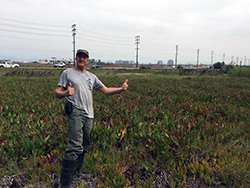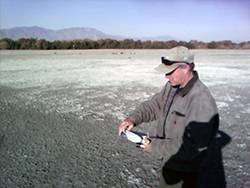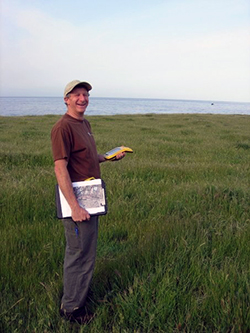


Richard Brody is a Southern California native who grew up “a stone’s throw” from the CDFW project he now manages, the Ballona Wetlands Ecological Reserve. Like many CDFW scientists, he took a circuitous route to working for the department, dabbling in early punk rock, owning an employment agency, home building and delivering large sailboats on the open ocean. Eventually he married, settled back into school and began a career in environmental science. Richard did his undergraduate work in water policy at Cal, and then went to graduate school at UCLA, studying Fluvial Geomorphology and Wetland Restoration. Today, he and his wife are raising two daughters in the open space of Topanga Canyon.
How did you come to CDFW?
After graduate school, I worked in the world of environmental consulting for over a decade. I was a wetland delineator and restoration specialist, and I got to know and highly respect the work CDFW was doing. In my mind, the holy grail of private restoration work was to one day manage a wetland reserve and have the time to concentrate on making a solid difference at one important location. Through my relationships at CDFW, I learned of the Ballona Land Manager position and was told that I would be an asset to CDFW. I was fortunate enough to be offered the position after a very competitive process.
What does the Region 5 lands program encompass?
The South Coast Region’s lands program manages coastal and inland properties from Santa Barbara County to the border of Mexico. These properties include maritime chaparral and sage-scrub communities, oak woodlands, grasslands, coastal bays, lagoons and estuaries. We manage these threatened habitats to protect them, but there are some passive recreation and educational uses allowed also. These vary from reserve to reserve.
What is Ballona and why is it important?
The Ballona Wetlands Ecological Reserve is the largest and last remaining opportunity for major coastal habitat restoration in Los Angeles County. It is located on the edge of one of the largest concrete jungles on the planet and also along the Pacific Flyway. Historically, this area provided a much larger stopover, resting and foraging area for migratory birds than is available today. There are corners of the Reserve that provide some estuarine and aquatic function, but only after years of coordination with our federal and local partners to restore some tidal flow. These areas are now a case study of what is possible and the immense potential this degraded Reserve offers. In the late ‘50s and early ‘60s, the world’s largest man-made small craft harbor was dredged out right next to where the Reserve now sits. Dredging of this harbor, channelizing Ballona Creek and building the surrounding community all contributed to the reduction of the once approximately 2,000-acre wetland to less than 600 acres today. Very little of the remaining wetland has any describable function anymore. In fact, the Howard Hughes Corporation accepted more than 3 million cubic yards of fill from the marina dredging to be dumped in the former wetlands.
This is the biggest challenge ahead of us – getting the Reserve back down to sea level and reconnecting Ballona Creek with its floodplain so the land can function as a coastal wetlands again. Restoring Ballona will offer hundreds of now-unavailable acres to wetland-dependent species that have been displaced all along our coastline and are now clinging to existence in the Los Angeles area. I tell my kids that the Once-ler came through Ballona and left a mess and that it is my job to help make the pond wet again and bring back the Swomee-Swans and the Humming-Fish. (The Once-ler is the narrator and a character in The Lorax by Dr. Seuss.)
If you had unlimited money for Ballona what would you do?
I would fast-track the restoration, acquire all other nearby available land for more open space and build a world-class visitor and research center at the Reserve.
What is your vision for Ballona?
Aside from the obvious restoration effort, Ballona has always been a politically charged place of many factions and competing interests. One of my top priorities is bringing people closer together here. The overwhelming majority of us have the same goal in mind – to make this a special place along the California coast. We don’t see eye-to-eye on every issue, but we have already made progress in communication. That’s the best place to start.
What species are documented at Ballona and what do we think will come there (or return) when the restoration is complete?
We currently have three species that are listed as threatened and/or endangered, as well as 11 species of special concern. This is compared to 18 threatened and endangered species and nearly 100 species of special concern that are documented to have once existed at Ballona, or are still in the area but have insufficient habitat to return. I am the eternal optimist who feels that if we get this restoration off the ground, we have the potential for most, if not all, of these species to be documented here again.
The El Segundo blue butterfly (Euphilotes battoides allyni) is federally endangered and listed by the state as critically imperiled. It’s the cutest little butterfly on the planet. It used to be primarily restricted to the LAX dunes about five miles away, but the Friends of Ballona worked tirelessly over the last decade clearing iceplant and planting seacliff buckwheat (Eriogonum parvifolium). This is the only host plant for this species that it uses in all of its life stages. Once it was planted, the butterflies came. The highest count we have seen recently was more than 500 butterflies. This is a huge success story and testament to how successful restoration can be at Ballona. Every summer, the Friends hold a butterfly festival in honor of all their hard and successful work.
In addition to the El Segundo Blue Butterfly, other threatened and endangered species breeding or overwintering at Ballona now include the Belding’s savannah sparrow and the least Bell’s Vireo. Our species of special concern include the legless lizard, burrowing owl and Orcutt’s pincushion, among others. We would like to someday reintroduce Ventura marsh milkvetch, a plant species formally thought to be extinct.
What would you tell a high school student who wants to study environmental science?
Choose a field that suits your lifestyle. I once had a biology instructor tell me that if you’re planning your field of research, why not study the thoracic region of tropical lobster? You’ll have to dive all day in the Maldives and bring home lobster tails every day. That’s a metaphor, but you get my meaning. Now you know why I specialize in coastal wetlands. Surfing and shorebirds, what more could a guy ask for?
Any final thoughts?
What I love most about Ballona is people’s passion and Ballona’s potential. To have this tiny little bit of tidal wetlands available to us, and the wildlife species that are here is an incredible opportunity.
Many people have told me that they can feel their blood pressure actually go down when they leave the concrete jungle, get off the 90 freeway, head down Culver Boulevard and see the open space of Ballona. That simple example shows how important open space is here in Los Angeles County. I often use the functions and values test here. Functions are measurable – we can measure water quality, biodiversity or habitat. But values are not as tangible. Ballona has an intrinsic value, and it brings a sense of well-being that is almost lost in coastal Los Angeles.